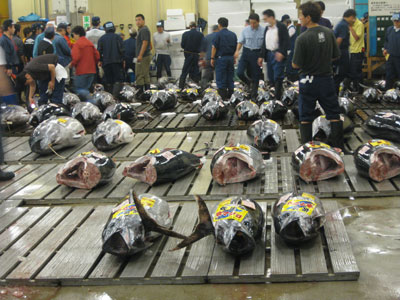Tokyo’s fish market
Traveling on a professional grant, I joined a group of five other educators for a June-July 2010 trip to Japan, where I experienced the warmth and beauty of Japanese culture in Tokyo, Oita, Hiroshima and Kyoto. A highlight was a visit to the tuna auction at the Tokyo Tsukiji Fish Market, also known as the Central Market, the world’s largest wholesale seafood market.
Tsukiji drives a thriving distribution system at the core of Japanese cuisine, delivering more than 2,000 tons of seafood daily to sushi counters and five-star restaurants.
The market is populated by 60,000 registered employees: wholesalers, distributors, auctioneers, officials and accountants. The inner market hosts the fresh and frozen seafood auctions, most notably the one for the prized blue fin tuna, which can command up to $10,000 apiece. The auctions begin at 5 a.m. and are completed in two hours.
Most of the wholesale business and fish processing occurs in the inner market. Marine life gets sawed and sliced in a hectic hall of workers while vehicles ply through tables and stalls.
The outer market consists of small retail shops offering food items, such as sushi, tempura and noodles, as well as household items, including small grills, pots and pans, teapots, pottery, ladles, chopsticks and handmade knives.
The market is located above Tsukiji Shijo Station on the Oedo Subway Line. To get there from Tokyo Station, take the Marunouchi Subway Line to Ginza, then transfer to the Hibiya Subway Line to get to Tsukiji Station (¥160, or $2). Each leg takes about three minutes. From Shinjuku Station, take the Oedo Subway Line directly to Tsukiji Shijo Station, a 20-minute ride (¥260).
Our group took the first subway train of the morning, arriving at about 5:20. We were met by an official as the sun’s first rays came over the warehouse roof. Donning neon-orange vests and white rubber boots, we followed him through the cool building, taking care not to get in the way of the turret trucks maneuvering around corners.
As we continued to another warehouse, we could see the chalky-white forms of frozen tuna aligned on the floor with the precision of calligraphy. Buyers with pens and flashlights circled, poked, prodded and otherwise examined the fish.
An auctioneer ascended a chair as buyers clutched their notepads. While the calls of the auctioneer could be heard, hand signals played out the competitive bidding process. As each fish was sold, it was marked with the buyer’s name, then hooked with a tool and dragged over to a cart by one or two sturdy men who looked as if they meant business.
The drama peaked in the narrow lanes formed by lines of tanks and plastic bins, the liquid-filled tubs bubbling with thrashing, wriggling, glistening inhabitants. Several stalls over, a gasp arose when a trio of tourists observed a half-skinned eel with a nail driven through its head.
In recent years, the number of visitors to the fish market has surged, and the auction observation area was subsequently closed to visitors on April 8, 2010. It reopened to visitors on May 10, with the number admitted to the auction now limited to 140 per day. A group of 70 visitors is admitted between 5 and 5:40 and a second group between 5:40 and 6:15.
Those who wish to attend must apply at the Osakana Fukyu Center (Fish Information Center) at the Kachidoki Gate, starting from 4:30 a.m. Entry, on a first-come, first-served basis, is free.
I would recommend visiting the market mid morning a day or so ahead of time to get the lay of the land and obtain firsthand information. Avoid Sundays, national holidays and every other Wednesday, when the market is closed.
It is important to heed posted rules and use common sense. Be mindful of the business being conducted; do not enter restricted areas; walk single file; go in a party of no more than five; wear comfortable walking shoes that can get wet; don’t bring small children, pets or large bags; avoid smoking, and watch for careening carts that can appear out of nowhere. As careful as I tried to be, I almost walked in front of one, displeasing the driver.
At all times, avoid using flash photography, particularly during the auction, so as not to distract bidders or interfere with the elaborate hand signals that can make or break a sale.
Visitors not attending the auction are discouraged from entering the inner market before 9 a.m., but, once inside, they can walk among the stalls, remaining respectful of workers. The outer market, which caters to the public, offers an array of fresh seafood stalls. A long line serves as the best indictor of where to eat.
By late morning, the market is packing up and shutting down.
KIMBERLY EDWARDS
Sacramento, CA

